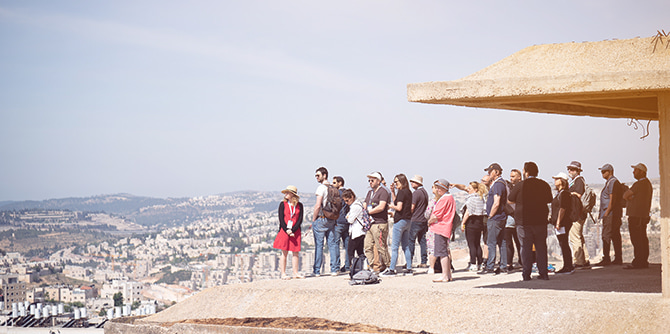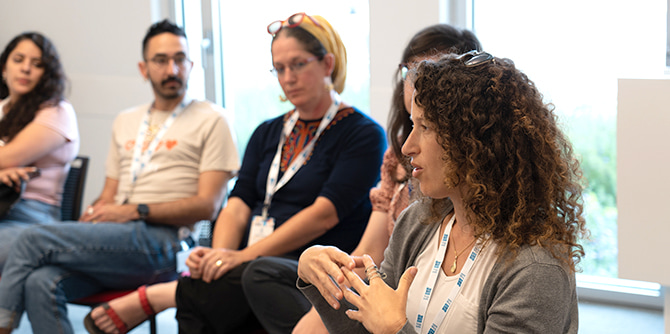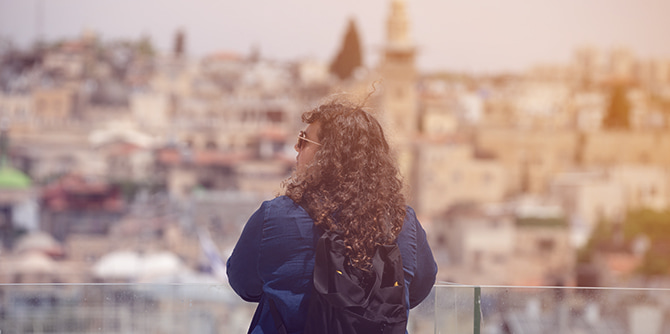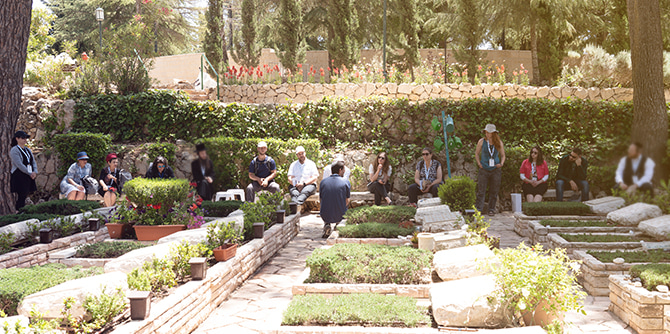 Fellows looking out from Tell El-Ful (Photo: Simanim Productions)
Fellows looking out from Tell El-Ful (Photo: Simanim Productions)
The city of Jerusalem is a microcosm of Israeli society, with its many diverse groups, and includes multiple “border areas” along various dividing lines – religious, social, cultural, political, demographic, symbolic, and more. The border areas and seamlines in Jerusalem manifest themselves in different ways. They provide opportunities for encounters between different faiths, values, historical accounts, and interest groups; raise a variety of human and ethical issues; are often the focus of a great deal of tension; and call for acts of leadership.
The seamlines of Jerusalem were the focus of a joint study day for all the fellows of the Mandel Leadership Institute, who come from different communities and sectors in Israeli society, and include leaders from the Haredi community, non-formal education, the world of Jewish culture, the Israel Defense Forces, and teacher education programs at universities and colleges. The Institute’s joint study days create an enriching professional environment for the fellows, introduce them to the various areas in which the Institute’s programs operate, and create opportunities for encounters and discussions between fellows of different programs. These events strengthen fellows’ knowledge of fundamental issues in Israeli society and facilitate challenging discussions of core conflictual topics, as part of the leadership development process.
 Fellows of the programs of the Mandel Leadership Institute (Photo: Simanim Productions)
Fellows of the programs of the Mandel Leadership Institute (Photo: Simanim Productions)
In the second joint study day of the year, the Institute’s fellows embarked on field trips in mixed groups of fellows from different programs, and explored case studies that showcase tensions or conflicts in Jerusalem. Examining these cases, while referring to the fellows’ professional experience in their own work environments, provided the basis for a discussion that centered around principles of leadership, particularly leadership that is aware of the complexities in which it operates. The tours served as a pedagogy for facilitating deep understanding and contemplation within the seam areas themselves, and the emerging insights created new and enriching links to the world of practice. As one of the fellows described it: “I only hear about the places we visited on the news. I never imagined that I would actually walk through them myself, and think about the conflict in such a clear manner.” By means of the tours, and the discussions that followed, the fellows were able to express their feelings, and spoke about the need to take responsibility.
The tours in which the fellows participated included the following:
A visit to the Temple Mount – Led by a pair of guides, one Jewish and one Arab, the Institute’s fellows visited the Temple Mount, one of the most contested places in the world in terms of inter-religious frictions and attempts to challenge boundaries. There, they explored how the political, religious, and social boundaries on and around the Temple Mount are set and tested, and how the shared spaces of this tiny area with an immense global impact are managed.
 A tour of the Old City of Jerusalem (Photo: Simanim Productions)
A tour of the Old City of Jerusalem (Photo: Simanim Productions)
Mount Herzl – Fellows toured Israel’s national military cemetery at Mount Herzl, where they delved into lesser-known stories of those who are buried there and explored questions of inclusion in and exclusion from national memory – questions with dynamic answers that shift in accordance with social attitudes during different eras. Led by Aviv Wishkovsky, a guide who researches the formation of collective memory in Israeli society, the tour focused on the process by which Mount Herzl was designed and explored the development of memory and the boundaries that have been placed on it by the shapers of Israeli statehood and national culture since the establishment of the State.
 A tour of Mount Herzl (Photo: Simanim Productions)
A tour of Mount Herzl (Photo: Simanim Productions)
Along the tracks – Fellows rode Jerusalem’s light rail, led by Dr. Marik Shtern, a geographer who studies cities in conflict, urban politics, and relations between groups in urban spaces. Jerusalem’s light rail, which connects opposite ends of the city, passes through various different border areas. The interfaces between different worlds within Jerusalem, interwoven along the track, offer a fascinating glimpse of the city’s complexity. Getting on and off the train at various stops, the fellows were shown how borders in Jerusalem can be historical, religious, or in people’s minds, and discovered that while the city’s walls may be solid or transparent, they are very much present at all times. In the words of one participant: “It’s a light railway – but nothing about it is light or easy.”
Natural and urban spaces – One group of fellows set out on a bicycle tour that explored the borders between natural and urban spaces within Jerusalem, and examined the social, educational, and physical consequences of crossing these borders. Conducted on a cycle path that surrounds the city, this tour facilitated a different form of movement through the cityscapes.
 Fellows of the Mandel Program for Academic Leadership in Teacher Training (Photo: Simanim Productions)
Fellows of the Mandel Program for Academic Leadership in Teacher Training (Photo: Simanim Productions)
Throughout the tours, the fellows encountered different expressions of the Psalmist’s reference to Jerusalem as “a city joined together” (Psalm 122). On the one hand, they saw the mixing of identities and meeting points, while on the other, they saw the fraying of relations, up to a point of clash and conflict. These encounters embodied the yearning expressed by the Israeli poet Yehuda Amichai, a longtime resident of Jerusalem, in his poem “Why Is Jerusalem Always Two?”:
“Why is Jerusalem always two, one above and one below?
And I want to live in the Jerusalem in the middle,
Without banging my head up top,
And without bruising my feet down below.”
For the Institute’s fellows, there was great value in meeting the fellows of the Institute’s parallel programs, whether in the tour groups or in the discussion groups that followed. The encounters allowed them to discuss issues of leadership in areas of conflict from very different perspectives, to broaden their viewpoints, and to shine a light on their blind spots. The encounters were an opportunity for fellows to step out of their comfort zones and hold discussions that were very fruitful, even if occasionally heated. These discussions gave rise to new connections, through which fellows could examine the social arenas in which they want to have an impact, and the type and extent of the impact they want to achieve. This allowed them to create potential partnerships that will help them cope with similar challenges in different fields of activity in the future.
